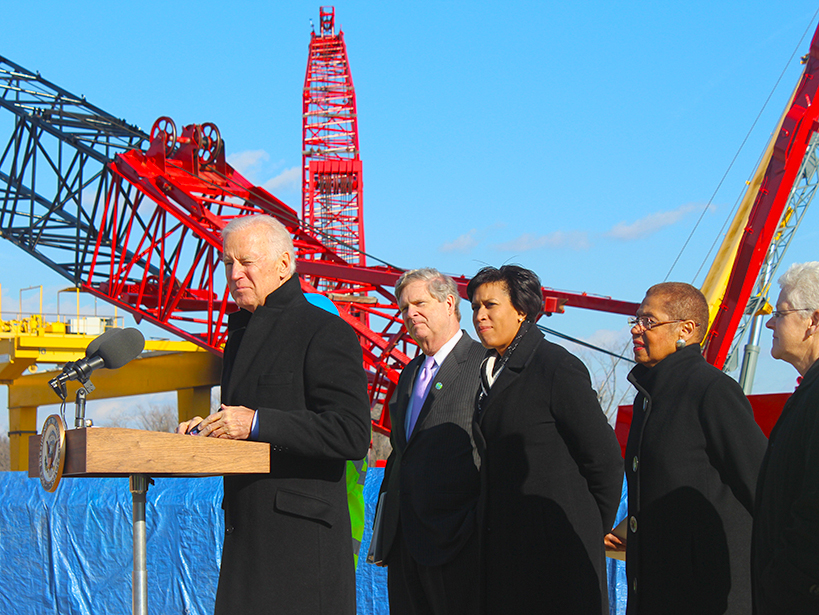As a prelude to the State of the Union address on 20 January, the Obama administration promoted its efforts on climate change and on infrastructure projects. The administration announced on 16 January several measures to increase investments in drinking water and wastewater systems and in other infrastructure projects.
Among these, the U.S. Environmental Protection Agency (EPA) launched a Water Infrastructure and Resiliency Finance Center to help local and state governments gain access to federal loan and grant programs and to promote public-private collaborations to address water infrastructure needs. The U.S. Department of Agriculture also announced a Rural Opportunity Investment Initiative to identify investment opportunities in water, energy, and other infrastructure projects.
In addition, administration and local officials recently highlighted D. C.’s $2.6 billion Clean Rivers Project. The effort aims for a 96% reduction of combined sewage overflows into the city’s waterways to improve water quality while also promoting resilience to climate change, they said.
Clean Rivers Project
Combined sewage overflows occur during heavy rain events when sewage and storm water—which travel through the same pipes—spill over into the nearest water body. In Washington, D. C., those water bodies are the Anacostia and Potomac rivers and Rock Creek.

Credit: Randy Showstack
The project broke ground in 2011. It involves building at least 15 miles of underground tunnels about 100-110 feet beneath the city to store the sewage and runoff in pipes until it can be conveyed to a water treatment plant. Construction of the longest underground segment, the 13 mile long Anacostia River Tunnel, began in 2014. That portion of the project is expected to be completed in 2018. Tunnel-boring machines equal in length to about 150 yards and that are more than 20 feet in diameter are digging primarily through a seam of sediment and heavy clay.
The effort is benefiting from some innovative financing. DC Water, which oversees the project, issued “century bonds” with a 100-year final maturity to match the life expectancy of the tunnels.
At a 16 January news event at a project site on the bank of the Anacostia River, Vice President Joe Biden and other officials said the project not only would help to clean the city’s water but could also be a driver for economic growth. Biden said the project provides decent-paying jobs and that businesses want to locate in places with good infrastructure and clean water.
“If we are going to lead the world in the 21st century,” he commented, “we have to have the most modern infrastructure in the world.” Biden said that more than 700 cities across the country have outdated water and sewer systems.
Building in Resiliency
EPA Administrator Gina McCarthy called the Clean Rivers Project “a miracle of modern engineering practices.” She added that through projects that modernize the nation’s water infrastructure, the agency’s new finance center “is going to help communities improve water and wastewater systems and build resilience in the face of a changing climate.” McCarthy said the country would need more than $600 billion over the next 20 years to maintain and improve its water infrastructure.
Tommy Wells, director of Washington, D. C.’s District Department of the Environment, stressed that the project is important in part because of changing conditions resulting from climate change. “We have to be sure that we have resilient cities, and the resiliency is tested by the climate change that we have seen with Hurricane Sandy but especially with Hurricane Katrina,” he told Eos. “Substantial climate change can shut down a city and you can lose billions of dollars not just in restoration of infrastructure but in lost business, lost revenue.”
Wells continued, “There is going to be more and more flooding around the country. This project, with [its] miles of tunneling, means that if there is a flash event of rain, which can and will happen again, we will be able to manage at least this river. We will be able to manage up to 98% of the rainfall year round, no matter how much rain comes in. So [the project] helps immensely on managing flood control.”
He added, “Frankly, we are going to have to figure out how to slow down if not reverse climate change in order for us to be able to have a resilient city environment.”
Preparation for More Frequent Storms
George Hawkins, chief executive officer and general manager of the District of Columbia Water and Sewer Authority, said the Clean Rivers Project “is a mammoth construction,” but it is solving a long term problem of combined sewage overflows.
Hawkins also focused on the relationship between resiliency and climate change. “The kinds of storms that cause the flooding that we are talking about are happening more frequently,” he told Eos. “Where you might have had this happen once every many years in the past, now it’s happening all the time. So, the need to have the overflow captured in a tunnel rather than going to a river or a neighborhood is more. The problem that we are solving is more prevalent now.”
—Randy Showstack, Staff Writer
Citation: Showstack, R. (2015), D. C. project aims to cut most storm water runoff problems, Eos, 96, doi:10.1029/2015EO022585. Published on 23 January 2015.
Text © 2015. The authors. CC BY-NC 3.0
Except where otherwise noted, images are subject to copyright. Any reuse without express permission from the copyright owner is prohibited.

